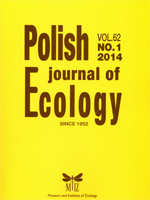In plants, biomass allocation and rhizome morphological plasticity reflect different strategies of adaptation to the environment. The aims of this study were to explore the patterns of allocation to different components of the belowground system, and to evaluate the effects of environmental factors on the plasticity of biomass allocation and rhizome morphology. We conducted a survey of the clonal plant, Scirpus planiculmis, in the Momoge wetland in northeastern China. Samples were collected at three sites. Site I is the washland of a seasonal lake. Site II is a permanent lake. Site III belongs to the bank of a recessive river. The average number of sampled plants was 686.25±91.61 per site. We determined the biomass of different plant parts (aboveground part, root, tuber, rhizome) and measured parameters of rhizome morphology (specific rhizome length, average rhizome diameter). Edaphic factors (soil moisture content, organic matter, available phosphorus, available potassium, pH, electrical conductivity) were included as environmental variables. Differences in biomass allocation patterns were analyzed and multiple regression analyses were used to construct a model. The results showed that the structure of the belowground system varied significantly among the three sites. (1) The tubers accounted for the largest share of biomass in plants at site I; (2) plants at site III showed significantly longer rhizomes than those of plants at site II, while the plants at site II showed larger rhizome diameter; (3) pH was the crucial factor affecting biomass allocation and rhizome morphology, and was negatively correlated with root biomass of S. planiculmis. Based on these results, we concluded that: (1) greater resource allocation to the storage organ (tuber) reflects a conservative strategy to avoid damage and to maintain the potential for recolonization in a frequently disturbed habitat; (2) the morphological plasticity of the rhizome increases the ability of the clone to acquire resources. Shorter rhizomes enable rapid colonization of the habitat and efficient resource use under strong competition pressure, while longer rhizomes are useful to explore new habitats when local resources are insufficient. Our results suggest that ecological niche of S. planiculmis should be reconsidered. It may be more appropriate to classify S. planiculmis as a facultative salt-alkali plant, although a degree of tolerance to salinity and alkalinity is important for the initial formation of a population.
How to translate text using browser tools
1 March 2014
Adaptive Significance of and Factors Affecting Plasticity of Biomass Allocation and Rhizome Morphology: a Case Study of the Clonal Plant Scirpus planiculmis (Cyperaceae)
Yu Ning,
Zhi Xiang Zhang,
Li Juan Cui,
Chang Lin Zou
ACCESS THE FULL ARTICLE

Polish Journal of Ecology
Vol. 62 • No. 1
March 2014
Vol. 62 • No. 1
March 2014
biomass allocation
Clonal plant
Momoge wetland
rhizome morphology
Scirpus planiculmis




